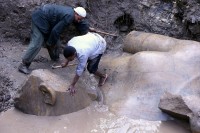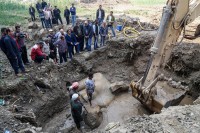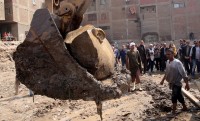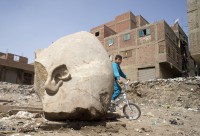 A team of Egyptian and German archaeologists have discovered the head and bust of a colossal statue, possibly of the Pharaoh Ramesses II, in a soggy pit in Matariya, a working class neighborhood of northeastern Cairo. The quartzite statue is 26 feet high. The lower part of the head, the crown, the right ear and a part of the right eye have been recovered. There is no cartouche identifying the pharaoh, nor any other inscription on the pieces of the statue that have been found, so archaeologists cannot be certain it was meant to represent Ramesses II. His temple was close to the find site, however, and he did love to make gigantic versions of himself, so he’s the leading candidate.
A team of Egyptian and German archaeologists have discovered the head and bust of a colossal statue, possibly of the Pharaoh Ramesses II, in a soggy pit in Matariya, a working class neighborhood of northeastern Cairo. The quartzite statue is 26 feet high. The lower part of the head, the crown, the right ear and a part of the right eye have been recovered. There is no cartouche identifying the pharaoh, nor any other inscription on the pieces of the statue that have been found, so archaeologists cannot be certain it was meant to represent Ramesses II. His temple was close to the find site, however, and he did love to make gigantic versions of himself, so he’s the leading candidate.
 Matariya’s mud roads and hastily erected buildings are perched above what was once the ancient city of Heliopolis. A center of religious devotion since the predynastic period, Heliopolis was deemed the home of the sun-god Atum, later Ra, and many successive pharaohs built or added onto temples there. The 18th dynasty king Thutmose III (r. 1479–1425 B.C.) built a temple that was the original home of two of the most famous obelisks in the world: the so-called Cleopatra’s Needle in Central Park, New York, and another so-called Cleopatra’s Needle in London. Tutankhamun’s father Akhenaten (r. 1353–1336 B.C.) had a temple built to his monotheistic iteration of the solar god, Aten. The solar temple built by Ramesses II (r. 1279–1213 B.C.) was so massive it was twice the size of the temple of Karnak.
Matariya’s mud roads and hastily erected buildings are perched above what was once the ancient city of Heliopolis. A center of religious devotion since the predynastic period, Heliopolis was deemed the home of the sun-god Atum, later Ra, and many successive pharaohs built or added onto temples there. The 18th dynasty king Thutmose III (r. 1479–1425 B.C.) built a temple that was the original home of two of the most famous obelisks in the world: the so-called Cleopatra’s Needle in Central Park, New York, and another so-called Cleopatra’s Needle in London. Tutankhamun’s father Akhenaten (r. 1353–1336 B.C.) had a temple built to his monotheistic iteration of the solar god, Aten. The solar temple built by Ramesses II (r. 1279–1213 B.C.) was so massive it was twice the size of the temple of Karnak.
 The German-Egyptian team have been excavating the Matariya site since 2012. It’s a race against time to stay ahead of construction, especially since a lot of isn’t legal and thus untroubled by zoning and proper permits. The site is also contaminated with industrial waste, rubbish and ever-growing piles of improperly disposed construction rubble. The difficulty is compounded by the fact that the ancient remains of Heliopolis are below groundwater level. Moving large objects like architectural features and colossal statuary, or even life-sized statuary, for that matter, out of the water to high and dry ground is challenging, hence the use of the bulldozer to fish out the head of the colossus.
The German-Egyptian team have been excavating the Matariya site since 2012. It’s a race against time to stay ahead of construction, especially since a lot of isn’t legal and thus untroubled by zoning and proper permits. The site is also contaminated with industrial waste, rubbish and ever-growing piles of improperly disposed construction rubble. The difficulty is compounded by the fact that the ancient remains of Heliopolis are below groundwater level. Moving large objects like architectural features and colossal statuary, or even life-sized statuary, for that matter, out of the water to high and dry ground is challenging, hence the use of the bulldozer to fish out the head of the colossus.
“We used the bulldozer to lift it out. We took some precautions, although somewhat primitive, but the part that we retrieved was not harmed,” said Khaled Mohamed Abuelela, manager of antiquities at Ain Shams University.
Egyptologist Khaled Nabil Osman said the statue was an “impressive find” and the area in the working class neighborhood of Matariya in eastern Cairo is likely full of other buried antiquities.
 The top section (measuring 2’7″ long) of a life-sized limestone statue of Pharaoh Seti II, grandson of Ramesses II, was also found at the Matariya site. Archaeologists hope to find more fragments of both statues as excavations continue. Conservators will work to piece them back together. If restoration is possible and more evidence is discovered identifying the colossal statue as Ramesses II, the huge sculpture will be moved to the entrance of the new Grand Egyptian Museum which is projected to open sometime next year.
The top section (measuring 2’7″ long) of a life-sized limestone statue of Pharaoh Seti II, grandson of Ramesses II, was also found at the Matariya site. Archaeologists hope to find more fragments of both statues as excavations continue. Conservators will work to piece them back together. If restoration is possible and more evidence is discovered identifying the colossal statue as Ramesses II, the huge sculpture will be moved to the entrance of the new Grand Egyptian Museum which is projected to open sometime next year.
Placing the head in an excavator bucket? I am sure there are other gentle ways of transporting centuries-old part of the statue without damaging it. It is not like they had to do everything in a big rush because of the weather or other reasons. Hopefully, they will use proper equipment and materials when assembling the statue.
Ozymandias
Percy Bysshe Shelley, 1792 – 1822
I met a traveller from an antique land
Who said: “Two vast and trunkless legs of stone
Stand in the desert . . . Near them, on the sand,
Half sunk, a shattered visage lies, whose frown,
And wrinkled lip, and sneer of cold command,
Tell that its sculptor well those passions read
Which yet survive, stamped on these lifeless things,
The hand that mocked them, and the heart that fed:
And on the pedestal these words appear:
‘My name is Ozymandias, king of kings:
Look on my works, ye Mighty, and despair!’
Nothing beside remains. Round the decay
Of that colossal wreck, boundless and bare
The lone and level sands stretch far away.”
Nice poem, and as a tourist from Greece reported almost 2500 years ago:
—————
“…works which are worth seeing for their size, and among them also at Memphis the colossal statue which lies on its back in front of the temple of Hephaistos, whose length is five-and-seventy feet; and on the same base made of the same stone are set two colossal statues, each of twenty feet in length, one on this side and the other on that side of the large statue. There is also another of stone of the same size in Sais, lying in the same manner as that at Memphis.”
Excavating with an excavator? I like toothed buckets too: they break stuff up very well. Germans you say? Does no one have pump?
And who smashed all this is the first place? The same folks who stripped the glacis stones off the Giza pyramids?